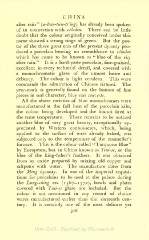Page 390 - Oriental Series Japan and China, Brinkly
P. 390
CHINA
after " (u-kwo-tien-ts* ing) has already been spoken
rain
of in connection with celadon. There can be little
doubt that the colour originally conceived under this
name showed a strong tinge of green. But the pot-
ter of the three great eras of the present dynasty pro-
duced a porcelain bearing no resemblance to celadon
which has come to be known as " blue of the sky
after rain." It is a hard-paste porcelain, fine-grained,
excellent in every technical detail, and covered with
a monochromatic glaze of the utmost lustre and
delicacy. The colour is light cerulean. This ware
commands the admiration of Chinese virtuosi. The
year-mark is generally found on the bottom of fine
pieces in seal character, blue sous couverte.
All the above varieties of blue monochromes were
manufactured at the full heat of the porcelain kiln,
the colour being developed and the biscuit fired at
the same temperature. There remains to be noticed
another blue of very great beauty, exceptionally ap-
preciated by Western connoisseurs, which, being
applied to the surface of ware already baked, was
subjected only to the temperature of the enameller's
furnace. This is the colour called "Turquoise Blue"
by Europeans, but in China known as Tsui-se, or the
blue of the king-fisher's feathers. It was obtained
from an oxide prepared by mixing old copper and
saltpetre with water. The manufacture dates from
the Ming dynasty. In one of the imperial requisi-
tions for porcelains to be used at the palace during
the Lung-ching era (15671572), bowls and plates
covered with Tsui-se glaze are included. But the
colour is not mentioned in any record of choice
wares manufactured earlier than the sixteenth cen-
tury. It is certainly one of the most delicate yet
316

